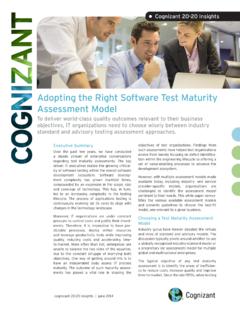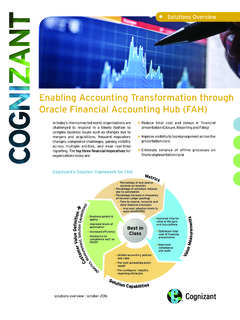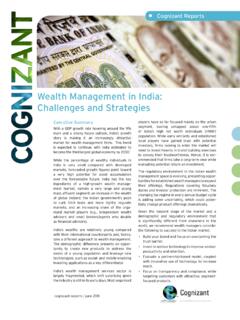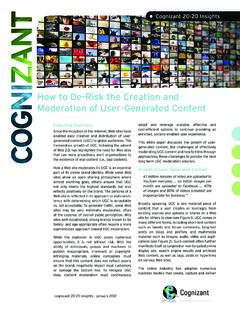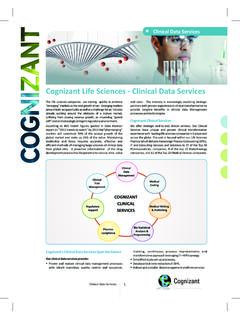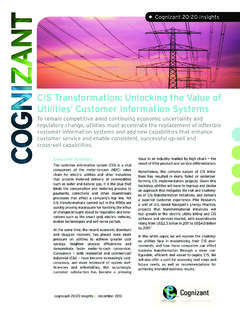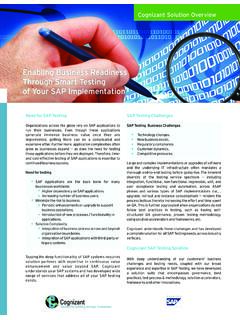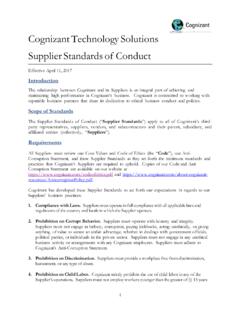Transcription of Helping People Heal - cognizant.com
1 Helping People HealTo improve outcomes, healthcare organizations must ensure their digital efforts to engage patients warm the industry s cold system of care with empathy, personalization and autonomy, our latest primary research reveals. 2As healthcare organizations work to heal pa-tients, they also hope patients are the cure for solving what ails the industry. Providers, payers and pharmaceuticals companies all hope building stronger relationships with patients will lead to better health outcomes and ultimately reduce the cost of care. The industry is investing heavily in digital initiatives designed to engage patients, connect them with physicians and help them follow doctors orders. But how well will these investments pay off? We know what a good health outcome is from the perspectives of payers, clinicians and hospitals. Yet in all the focus on patient- centricity, it s not clear how patients define a good outcome.
2 The industry can t truly engage patients without understanding their view of the healthcare system and their perceptions of how they heal . Without that understanding, digital patient engagement investments are likely to yield disappointing we studied the phenomenon of healing to truly understand what happens when People face a health issue or risk and need to manage or overcome it. We took an outside-in perspec-tive, delving deeply into the lives of Americans across the country to gain insight into how a per-son goes through a successful healing process. When the system doesn t help People heal , what do they do instead? Our researchers immersed themselves in People s everyday lives, visiting People in their homes, shadowing them at the physician s office, taking part in their daily routines. We intentionally chose to look across diseases to find patterns in healing strategies and recruited for the most prevalent and chronic conditions.
3 Further, we gained insight not just into the lives of our initial patients but into their respondent ecologies : the friends, families, colleagues and physicians that surround them. Finally, we validated the qualitative research with a large quantitative findings indicate the healthcare indus-try s efforts to engage patients are based on an array of faulty assumptions that calls for patient engagement to prioritize measurable outcomes; reinforces one-size-fits-all patient journeys; and tries to reduce the risk of patients deviating from treatment plans. We call this a cold system of patient engagement. These industry misconceptions, contrasted with patient realities, include: The current system measures healing by numbers; patients measure healing by their ability to function. The industry tries to optimize medical health measures; patients care about their quality of life. Expert health prescriptions are the norm; patients instead rely on their peers experi-ences for individualized guidance.
4 The industry has invested in mapping linear patient journeys; patients, however, take steps forward and back as they heal . The prevailing wisdom is that it s better to ask patients to do less; our research shows patients and caregivers will go to great effort to minimize SummaryHelping People heal | 3 The industry has put a premium on using electronic medical/health records (EMRs/EHRs) to capture full medical histories; pa-tients want assistance in telling the human story behind their medical information. The industry focuses on telling patients exactly what to do; patients instead need to go through a process of trial and error to find what works for them. The industry treats conditions instead of individuals; patients can follow treatment plans exactly and yet not feel like they are healing. The current system focuses on patients as the sole agents of medical adherence; however, healing does not occur in isolation and is an evolving process that involves many cold system of healthcare makes it harder for patients to heal , in part by pushing them away from the practices that help them manage their care.
5 Much investment in digital tools and techniques to date has unfortunately been aligned with the misconceptions uncovered by our propose a new model for patient en-gagement. Our core idea is that we should use digital to warm patient engagement by bringing a more human touch, empathy and greater warmth, and by empowering study demonstrates that when patients get warm care, they are more likely to engage in successful behavior change, and more likely to be adherent. This points to a huge opportu-nity for digital patient engagement. Digital can be applied to warm up patient engagement by enabling People s life goals, personalization and discovery. When most People think about digital, warmth isn t likely the first association that jumps to mind. Today, popular narratives about digital s promise often frame it as something mechanical and somewhat dehumanizing. By this logic, digital is cold and efficient, while humans are warm, if less than perfect.
6 But digital can, and should, be warm. Digital is uniquely positioned to enable warm care with individualized, adaptive, empathetic and scalable support. That s why we think that the road to improved outcomes runs through s Temperature DivergenceGOALPROCESSAPPROACHM easurable outcomesOne-size-fits-all patient journeysReduce the risk of patients deviating from treatment Healing is a means to achieve life goalsHealing journey happens throughpersonalized nudgesDiscover how to healColdSystemWarmCareFigure 14We propose a new model for patient engagement. Our core idea is that we should use digital to warm patient engagement by bringing a more human touch, empathy and greater warmth, and by empowering People heal | 5It s table stakes to talk about patient-centricity and patient empowerment. By empowering patients with more information, more choice and shared decision-making in the healthcare pro-vider (HCP)-patient relationship, the goal is to enable patients to take ownership of their health.
7 If they can take ownership, patients will be more responsible in following their treatment plans, going for annual wellness visits and taking their prescribed medications. But when you spend time with Americans, you see and hear a vastly different story. Far from being empowering, today s health system is disempowering, because patients are asked to play by the system s logic. We spent a few days over the course of a month with Lauren, a 58-year-old mother who works two jobs in suburban New Jersey. She showed us a prescription her doctor had recently written for her thyroid medication. When she went to fill it, rather than costing the usual $11, it had jumped to $300 and she had no idea why. I used to know my health benefits to a tee, but now they re so complicated, she explained. She ended up having to call her pharmacist, doctor and insurance provider to find out, triangulating between the three.
8 Lauren s story is not unique; the industry is aware that People struggle to navigate complex healthcare bureaucracies. But the result of these struggles is underplayed: Lauren decided not to fill her prescription. The outcome? No refills, and a new risk to a patient s health. Across the country, People are constantly asked and are struggling to play by the system s logic. Take Daryl, a 50-year-old living in Dallas, who is diabetic, has diabetes-related neuropathy and has difficulty managing his weight. He talked to us at length about his doc-tors visits. I try to use the technical terms, and throw in numbers, he explained. He s worried that if he doesn t, the doctor won t be able to follow him, but the result is that he ends up feeling overwhelmed by the challenge of making himself fully understood by his doctor. Frustrated by a recent experience, he skipped a scheduled appointment, and when we met him he was con-sidering skipping more.
9 We went to soccer practice with Maria, 29, and her young son, in Texas. From the sidelines, Maria told us that We re supposed to avoid triggers for my son s asthma, but we want him to play soccer. He needs to lean in, otherwise he s not going to get better. Because Maria was asked to follow a generic treatment plan that didn t account for her aspirations for her son s life, she ended up not following the plan. Meanwhile, we met with Candy, 76, in a town outside Boston. After we went to a doctor s Part 1:Our Cold System Leaves Patients Frustrated and Overwhelmed 66appointment with her, she ex-plained, My doctor considers my heart serious medical stuff, so I feel like I should talk about that. But really my leg bothers me more. Patients are being asked to treat the health system s goals as their own. But the result is two-fold: their other needs can take a backseat, and, in Candy s case, she doesn t always take her heart medication as prescribed.
10 We call this a cold system, because it is set up to optimize efficiencies and reduce the risk that patients make mistakes in treatment. This plays out in three ways: Goal: Measurable health outcomes: The shift toward value-based care has resulted in an increased emphasis on healing by numbers. Process: One-size-fits-all patient journeys: The industry has invested heavily in personas, and understanding the typical patient at each stage of the journey. Approach: Reduce the risk of patients deviating from treatment: To address noncompliance, the industry demands perfection from patients from day one in treatment regimens. While healthcare and life sciences have placed increasing emphasis on understanding and engaging patients, the disconnect between patients and the system remains pervasive. This isn t because patients don t want, or are not able, to take control of their health. Instead, it is because empowerment often means that the patient needs to adapt to the system, and not the other way around.

